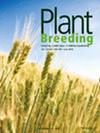改善胚乳水合作用,消除大麦(Hordeum vulgare)休眠与麦芽质量之间的负相关关系
IF 1.8
4区 农林科学
Q2 AGRONOMY
引用次数: 0
摘要
对大麦的休眠期进行了深入研究,结果表明它会对麦芽质量产生负面影响,从而导致对休眠期的选择。然而,休眠期的缩短会增加收获前发芽(PHS)的风险,因此,如果能克服休眠期对麦芽品质的负面影响,将休眠期重新整合到美国大麦品系中将会引发新的兴趣。我们在双亲图谱群体中评估了休眠和水合指数(HYI),以确定既能防止 PHS 又能获得良好麦芽品质的基因型。我们发现了 4 个 HYI QTLs 和 4 个休眠 QTLs,其中一个靠近已被充分描述的 SD2 QTL。HYI QTL与种子大小(1H)、休眠(5H)和麦芽质量(2H)有多向关系。休眠(5H)和 HYI(2H 和 3H)增加的品系的麦芽质量与非休眠品系相似,同时保持了对 PHS 的抗性,这表明 HYI 的改善可能是克服休眠对麦芽加工负面影响的关键。本文章由计算机程序翻译,如有差异,请以英文原文为准。
Improvement of Endosperm Hydration Counter the Negative Relationship Between Dormancy and Malt Quality in Barley (Hordeum vulgare)
Dormancy in barley has been thoroughly studied and shown to negatively impact malt quality, resulting in selection against dormancy. However, reduced dormancy coincides with increased preharvest sprout (PHS) risk, thus sparking a new interest in integrating dormancy back into American barley lines if the negative effects of dormancy on malt quality can be overcome. We evaluated the dormancy and hydration index (HYI) in a biparental mapping population to determine the genotypes that would protect against PHS but have good malt quality. We found 4 HYI QTLs and 4 dormancy QTLs, one of which was near the well‐described SD2 QTL. The HYI QTLs were pleiotropically related to seed size (1H), dormancy (5H) and malt quality (2H). Lines with dormancy (5H) and increased HYI (2H and 3H) had malt quality similar to nondormant lines while maintaining PHS resistance, suggesting improvements in HYI could be the key to overcoming the negative effects of dormancy in malting.
求助全文
通过发布文献求助,成功后即可免费获取论文全文。
去求助
来源期刊

Plant Breeding
农林科学-农艺学
CiteScore
4.40
自引率
5.00%
发文量
74
审稿时长
3.0 months
期刊介绍:
PLANT BREEDING publishes full-length original manuscripts and review articles on all aspects of plant improvement, breeding methodologies, and genetics to include qualitative and quantitative inheritance and genomics of major crop species. PLANT BREEDING provides readers with cutting-edge information on use of molecular techniques and genomics as they relate to improving gain from selection. Since its subject matter embraces all aspects of crop improvement, its content is sought after by both industry and academia. Fields of interest: Genetics of cultivated plants as well as research in practical plant breeding.
 求助内容:
求助内容: 应助结果提醒方式:
应助结果提醒方式:


